Artist Rick Amor and subject Shane Maloney relate divergent experiences of the creation of Shane's portrait.
This video was produced with funds donated by Tim Fairfax AC.
Artist Rick Amor and subject Shane Maloney relate divergent experiences of the creation of Shane's portrait.
This video was produced with funds donated by Tim Fairfax AC.
Rick: Well, the first idea was, I planned to enter the Archibald Prize in 2005. And the Archibald Prize tends to be big heads on big canvases. And I thought I’d do a big canvas with a small head. So I noted down an idea for it. I didn’t know who I’d do. And a couple of months later, a couple of weeks later, I saw Shane Maloney at Mario’s in Fitzroy.
Shane: He approached me when I was having coffee one morning. We both sort of went to this, you know, we both patronised the same coffee shop. And he said, “Would you like to sit for a portrait?” I was delighted to do so. I guess it’s somewhat flattering. I was interested in the process, about which I learnt absolutely nothing.
Rick: It goes through various stages. You sort of refine the idea as you go; you make drawings to change things and so on. This was the first idea for the portrait, the big painting with a small head, but I hadn’t thought of a sitter at this point. That was in May 2004. And, met Shane Maloney in the meantime, so his name appears now on the figure, but I haven’t yet found a setting. The next month, no, the next week, I’ve got the setting based on an old drawing that I found and Shane sort of appearing in the, that setting now. And the format’s sort of been worked out. It was a bit squarer than the finished one. Here I did a small study with myself as the portrait, just to try it out, a half size study. And there’s the layout for the finished Shane Maloney one. And I think there’s only one more. It was this one, where the tree appears and some architectural notes made. And that’s pretty well it. And I probably just started working on the canvas squared it up, did the golden moon over it, and started painting.
He came out and I made a study of his head. Normally I have five sittings for a portrait. That’s what I’ve found is, you know, works the best. And always work from life with a head in hands. The clothing I photograph, because that’s boring painting ... shirts and things with a person sitting. It’s just wasting their time, basically. I tried out the setting first by doing a self portrait in the setting. I left the tree out, just to see how it looked, but then I put the tree back in when I did the Maloney portrait. But that’s a half size version of the painting, study. There’s no sort of, you know, boxing in the dark. You know what you’re doing all the time. But yes, always from life, and about an hour and a half, two hours per sitting. And strangely enough, people seem to enjoy it.
Shane: You get to spend a pleasant hour in a turpentine-infused room, having a bit of a chat and then in due course this portrait appears.
Rick: It’s a bit of a myth that idea, the artist sees into the very soul of a person. I mean, if you can get a likeness that’s all you really want to do. If the likeness is good enough, something will come through of a person. I think with the portrait of Peter Doherty, the character of the man came through. I mean, I wasn’t trying to do anything. It just happened that way. The Shane Maloney and the Cosgrove picture are more sort of paintings rather than portraits, ‘cause they have some landscape or they have buildings or other figures. It’s more of a complicated business. And I found the setting for the painting in an old drawing I’d done in 2000 of an alleyway in Melbourne called Highlander Place.
Shane: It’s a fictitious alleyway, it’s not actually there in that configuration, but I knew where we were immediately. I could tell. My books are set in the sort of immediate past, usually about 10 years back from the time of publication, and I’m often touching on aspects of the cityscape which have been transformed. Things happen at buildings which are no longer there.
The building that looms on the left, it’s got a big plate glass, tinted plate glass window. So it’s a late Victorian building which has been modernised, modified. There’s something going on there in the background. There’s a figure in a shirt. Now, could be a waiter, could be an office. Right. No, so there’s a question.
Rick: The building on the right’s probably pretty close to what was there, except I think I put in the underground car park. The flyover as it was. That bit of carved masonry comes from Flinders Street, around the corner. And this is what I made up. It’s like in a dream ... I’ll often use the same setting and things, as if time is passing, something’s gone, something’s, you know, stayed and remained. And, like, there’s all these links through the paintings of the same objects that have survived or not survived or whatever, you know?
Shane: He had dealt with both me as a subject and my subject matter, which very often is the city, this city, Melbourne. For me the particular things about this place coincide with my particular interests, so the politics, the way that the history is written in the built form. And I think that there’s a limit to the social mobility here that, in Melbourne you’ll find the same people have been to school together, been to university together, you know, practised the professions together, and now they all sit on the, you know, bench of the County Court together, whatever it may be, but ... and this means that the hidden patterns, the hidden connections, the, not even hidden, just that there are many connections between people that are there but they’re not immediately visible. As a writer looking at the way a, the physical surroundings in the city can offer themselves as mood or plot opportunities or scenarios and settings has been built into this. It wasn’t my ugly mug, which he had the good sense to make very small, but it’s in fact a portrait of my writing process, which is really quite remarkable I think.
Well, I mean, naturally I was disappointed when I realised I wouldn’t be portrayed on a horse with epaulets and a full set of medals and perhaps, you know, a hat with a feather in it. I had been hoping for that.
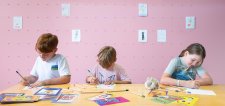
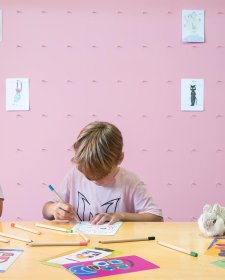

Drop into the Gallery any time for free creative activities inspired by artist Thom Roberts and his exhibition, The Immersive World of Thom Roberts.
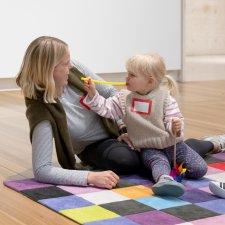
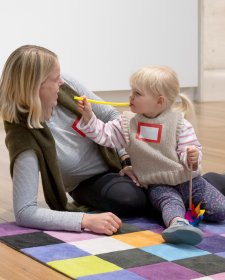
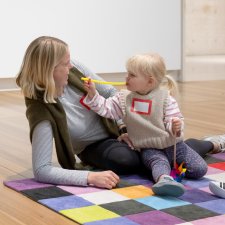
Join us for Portrait Play these school holidays as we explore portraits and music. Come and meet the people that live on our walls, discover musical instruments hidden in the portraits and get creative on your journey through the galleries.

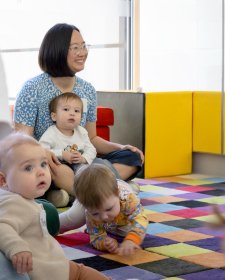

Do we have a treat for the smaller humans in your life! Little Faces is for babies and toddlers (with their grown up) to play, sing and have fun discovering a portrait together.